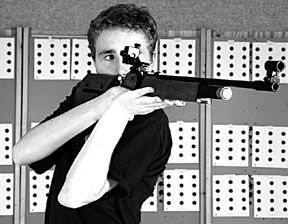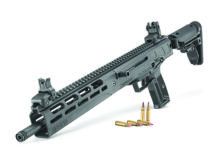
Daisy, the manufacturer whose products are synonymous with youngsters learning to shoot, has settled a lawsuit with the Consumer Product Safety Commission (CPSC). The CPSCs suit, which was filed in 2001 by then-Commissioner Ann Brown, a Clinton appointee, claimed that the Daisys air guns were defectively designed.
Following two years of discovery, CPSC approved a consent agreement and in a statement issued by CPSC Commissioner Mary Sheila Gall, she concluded, There is very little credible evidence that the Model 856 and 880 air rifles, in either their present or past configurations, represent a substantial product hazard.
Responding to the settlement, Daisys vice president of marketing, Joe Murfin, said, Unsafe behavior is at the root of air gun accidents, and he pointed out that Daisy has always aggressively promoted safe handling of its products through its Take Aim at Safety program, which instills safe and proper handling of firearms among those young adults for whom the companys products are intended.
In the settlement, Daisy agreed to undertake a $1.5 million dollar campaign to provide more frequent and enhanced safety warnings on its air rifles, to include similar warnings with BB packaging, and to continue to participate in voluntary standard-setting efforts with members of its industry and consumers.
This entire litigation was unwarranted and ill-conceived. Daisys enhanced safety warnings and other voluntary measures could have been implemented years ago, something NSSF had urged the CPSC to consider before it filed its lawsuit, said Lawrence Keane, vice president and general counsel of the National Shooting Sports Foundation (NSSF), the trade association of the firearms industry. Keanes view was shared by Commissioner Gall who expressed her extreme dissatisfaction with the way this case was brought and handled and how Daisy was treated by the CPSC. Gall, who had in 2001 voted against bringing the case, said that in her 11 years on the Commission and in her 30 years of government service she had never seen a more outrageous miscarriage of justice and abuse of the process of public policy. Gall said the evidence in the case showed that former Commissioner Brown had ordered the case against Daisy be removed from the ordinary process of Commission staff review because [Brown] did not like the conclusions of [career staff].
For further details, log on to www.cpsc.gov/cpscpub/prerel/prhtml04/04033.html.
———-
NRA To Become Broadcaster?
Hoping to spend as much as it wants on next years elections, the National Rifle Association is looking to buy a television or radio station and declare that it should be treated as a news organization, exempt from spending limits in the campaign finance law.
Were looking at bringing a court case that were as legitimate a media outlet as Disney or Viacom or Time Warner, the NRAs executive vice president, Wayne LaPierre, said in an interview.
Why should they have an exclusive right to relay information to the public, and why should NRA not be considered as legitimate a news source as they are? Thats never been explored legally, he said.
The nations gun lobby is talking with potential investors about an NRA broadcast outlet and is considering all possible funding sources, including gun manufacturers, LaPierre said.
If the NRA were to be considered a media organization, it would be free to say what it wanted about candidates at any time and spend corporate money to do so, such as for commercials.
The group, financed in part with corporate money, is now banned under the campaign finance law from running ads, just before elections, that mention federal candidates who are on states ballots.
LaPierre said even without a television or radio station, the groups communications reach is extensive enough that it should be considered part of the media. The NRA is one of the biggest magazine publishers in the United States and provides news over the Internet, LaPierre said. The group has close to a dozen publications, including American Rifleman and American Hunter magazines.
LaPierre said the organization may pursue the media exemption even if its previous challenge to the campaign finance law should prevail in the Supreme Court, which is expected to rule soon. The NRA could ask the Federal Election Commission whether it qualifies for the media exemption, take the issue to court, or both. The finance law, which took effect in November 2002, bars interest groups financed with corporate or union money from airing television and radio ads the month before a primary and two months before a general election if the ads identify federal candidates, are paid for with corporate or union money and target candidates districts.
News organizations are exempt from the restrictions. That allows them to cover the news, write editorials endorsing or opposing candidates, and air interviews. The NRA and its lawyers will look at every option to continue to exercise our First Amendment rights, LaPierre said.
———-
FBI Reports: Crimes Downward Spiral Continues
Violent crime reported to law enforcement in 2002 decreased 0.9 percent over the previous year, with 1.4 million estimated offenses. Five-year and 10-year trend data revealed the estimated number of violent crimes was 7.0 percent lower than the 1998 number and 25.9 percent less than the 1993 number. The weapon data collected for murder, robbery and aggravated assault showed that offenders used personal weapons, such as hands, fists, and feet, in 31.2 percent of these crimes. Firearms were involved in 26.8 percent of murders, robberies and aggravated assaults, and knives or cutting instruments were used in 14.9 percent. Other types of weapons were used in 27.1 percent of murders, robberies, and aggravated assaults.
———-
STI Acquires Frame Maker
STI International, Inc. of Georgetown, Texas, announced today that it has acquired all of the physical and intellectual assets of what was previously known as Lone Star Armament in Stephenville, Texas.
STI builds the 2011 series of semi-automatic handguns. It also makes 1911 pistols under the Trojan series name, along with the Master and Duty single-stack 1911 high-end specialty lines.
Lone Star Armament is known for its high-quality forged and bar-stock frames and slides, which were sold to other high-end manufacturers in the 1911 community. Lone Star labels include Lawman and Ranger .45 ACP series, introduced 2002-2003.
David L. Skinner, president and CEO of STI International, said that while the Lone Star name has been phased out, that line of forged frames, slides, and firearms will still be offered to the consumer. This purchase increased STIs pistol production capacity twofold and their component capabilities by a factor of five, Skinner said.
———-
NICS Rejections Lower
The National Instant Criminal Background Check System last year blocked about 136,000, or roughly 1.7 percent, of the attempted firearms purchases made through the nations gun dealers, slightly below the rejection rate in 2001, according to the U.S. Justice Department. About half of the 2002 rejected purchasers were convicted felons or those who had been indicted for a felony, 14 percent were blocked because of a domestic violence conviction or restraining order.
———-
HK Breaks Ground
HK has begun developing a domestic manufacturing base for its United States operations with a new factory being opened in Columbus, Georgia.
Establishing an American manufacturing base has been our number one priority, said HK, Inc. Vice President Peter Simon. Our Georgia factory represents Heckler & Kochs commitment to U.S. military and law-enforcement communities, to Americas war on terrorism, and to the creation of skilled manufacturing jobs for Americans.
HK will locate its new facility in 1,500-acre Muskogee Technology Park. The new facility will be built on 29 acres with a 75,000 square-foot building split as 20,000 square-feet for offices and 55,000 square-feet for manufacturing. It is estimated that the project will create 200 jobs and $25,000,000 in capital investment.
The plant will incorporate most of the advanced manufacturing techniques currently in place in Oberndorf, Germany. This includes the cold hammer forging of gun barrels, advanced polymer molding, and the computer-aided design and machining.
The primary markets for the firearms produced by the American plant will be for American police and military. Potential design and military contracts include the Armys XM8 assault rifle program. Significant quantities of the new HK pistol chosen by the Transportation Security Administration, the USP40 Compact LEM, will be manufactured there.
It is anticipated that the survey work and design will be completed in the next few months, with plant construction to begin in early 2004.



























